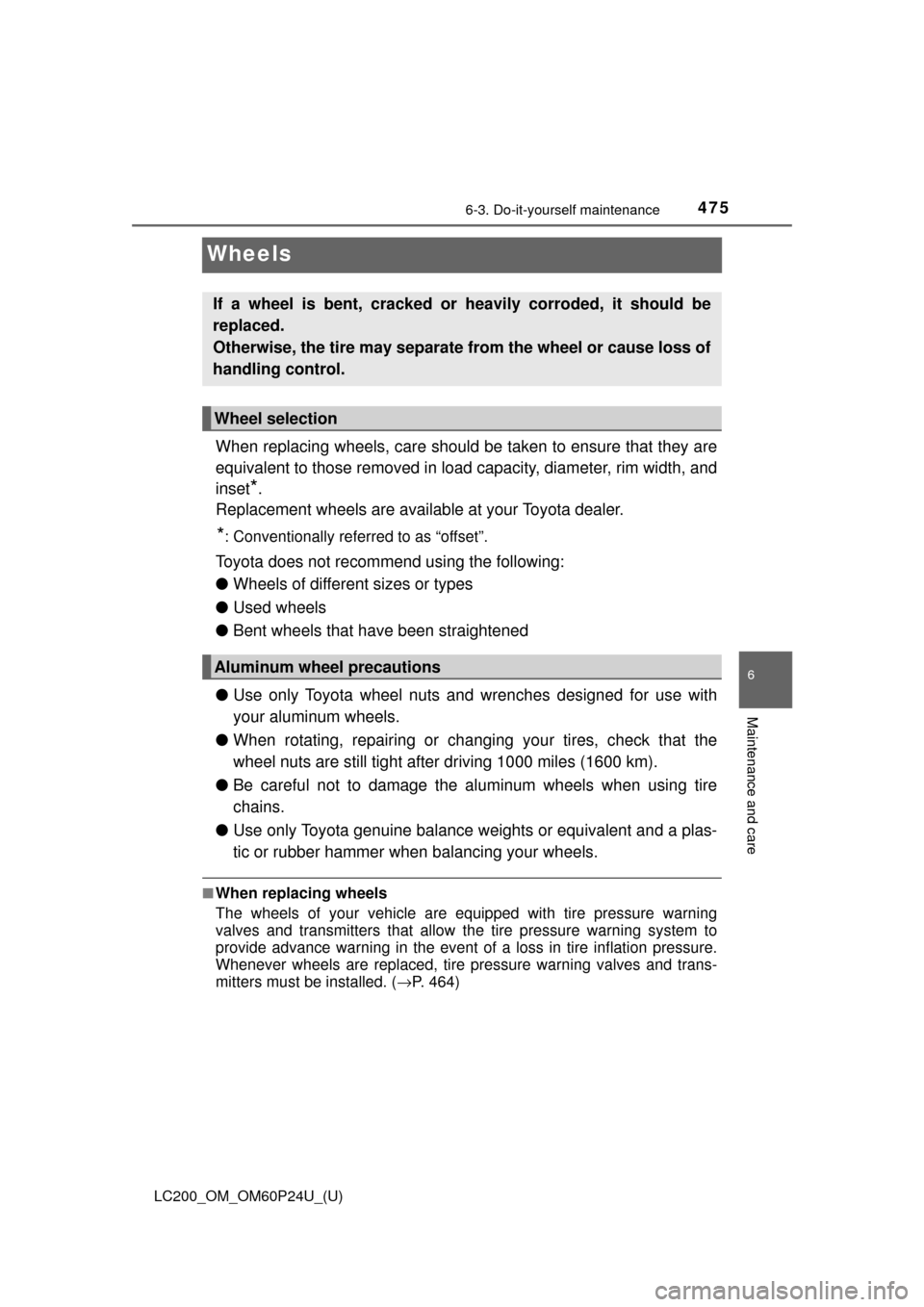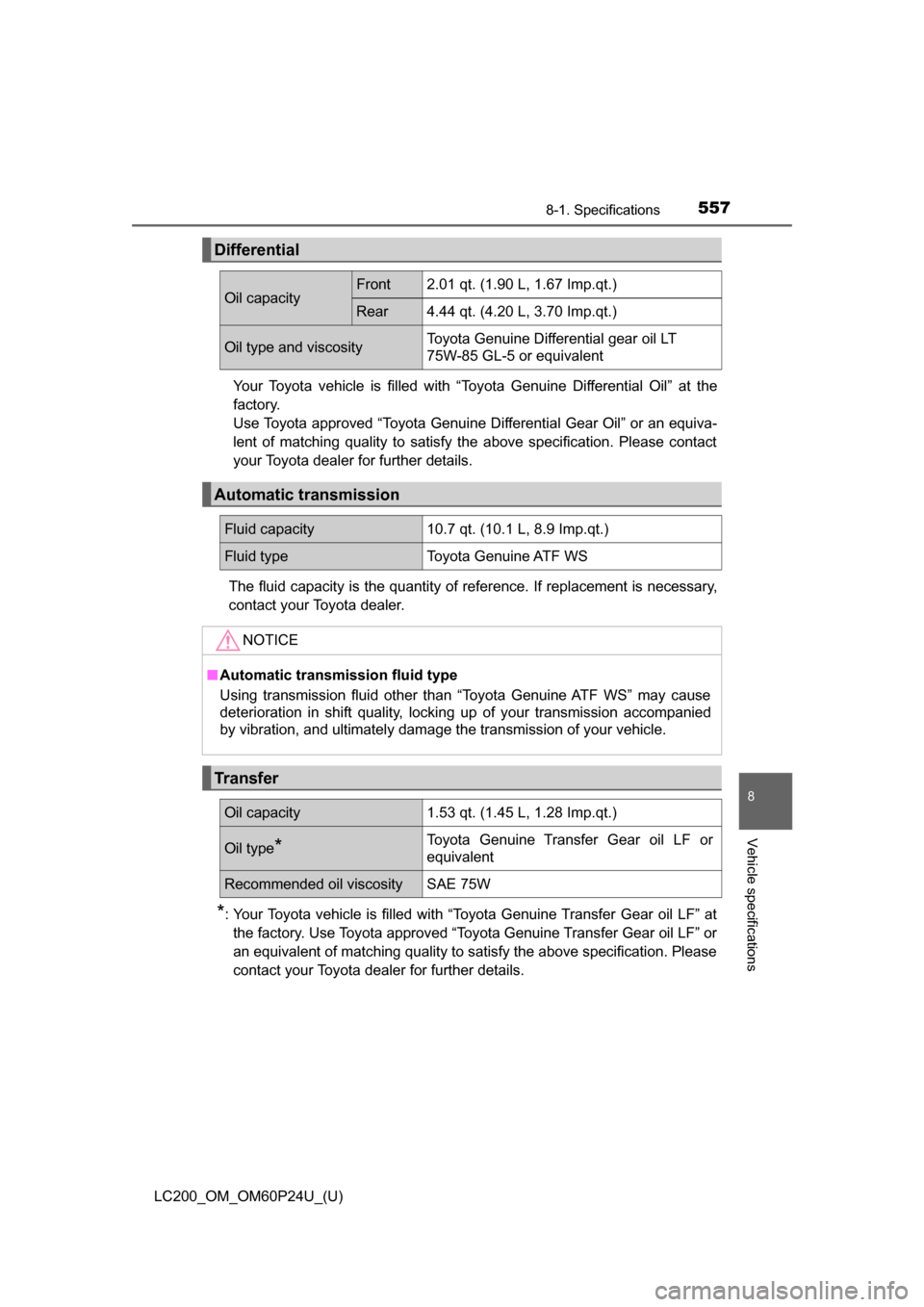Page 363 of 608

LC200_OM_OM60P24U_(U)
3634-5. Using the driving support systems
4
Driving
WARNING
■When the VSC and Trailer Sway Control are activated
The slip indicator light flashes. Always drive carefully.
Reckless driving may cause an accident. Exercise particular care when the
indicator light flashes.
■
Replacing tires
Make sure that all tires are of the same size, brand, tread pattern and
total load capacity. In addition, make sure that the tires are inflated to
the specified tire pressure level.
The Multi Terrain ABS, Active TRAC, VSC and Trailer Sway Control will
not function correctly if differen t tires are fitted on the vehicle.
Contact your Toyota dealer for furt her information when replacing tires
or wheels.
■Handling of tires and suspension
Using tires with any kind of problem or modifying the suspension will
affect the driving assist systems, and may cause the system to malfunc-
tion.
■ Trailer Sway Control precaution
The Trailer Sway Control system is not able to reduce trailer sway in all situ-
ations. Depending on many factors such as the conditions of the vehicle,
trailer, road surface, and driving environment, the Trailer Sway Control sys-
tem may not be effective. Refer to your trailer owner’s manual for informa-
tion on how to tow your trailer properly.
■ If trailer sway occurs
Observe the following precautions.
Failing to do so may cause death or serious injury.
● Firmly grip the steering wheel. Steer straight ahead.
Do not try to control trailer swaying by turning the steering wheel.
● Begin releasing the accelerator pedal immediately but very gradually to
reduce speed.
Do not increase speed. Do not apply vehicle brakes.
If you make no extreme correction with the steering or brakes, your vehicle
and trailer should stabilize. (→P. 189)
Page 467 of 608

LC200_OM_OM60P24U_(U)
4676-3. Do-it-yourself maintenance
6
Maintenance and care
■Tire types
●Summer tires
Summer tires are high-speed performance tires best suited to highway
driving under dry conditions. Since summer tires do not have the same
traction performance as snow tires, summer tires are inadequate for
driving on snow-covered or icy ro ads. For driving on snow-covered
roads or icy roads, the use of snow tires is recommended. When install-
ing snow tires, be sure to replace all four tires.
●All season tires
All season tires are designed to provide better traction in snow and to
be adequate for driving in most winter conditions as well as for use
year-round. All season tires, however, do not have adequate traction
performance compared with snow tires in heavy or loose snow. Also, all
season tires fall short in acceleration and handling performance com-
pared with summer tires in highway driving.
●Snow tires
For driving on snow-covered roads or icy roads, we recommend using
snow tires. If you need snow tires, select tires of the same size, con-
struction and load capacity as the or iginally installed tires. Since your
vehicle has radial tires as original equipment, make sure your snow
tires also have radial construction. Do not install studded tires without
first checking local regulations fo r possible restrictions. Snow tires
should be installed on all wheels. ( →P. 370)
■When rotating the tires
Make sure that the engine switch is off. If the tires are rotated while the
engine switch is in IGNITION ON mo de, the tire position information will
not be updated.
If this accidentally occurs, either turn the engine switch to off and then to
IGNITION ON mode, or initialize the system after checking that the tire
pressure is properly adjusted.
Page 474 of 608

474
LC200_OM_OM60P24U_(U)
6-3. Do-it-yourself maintenance
■Instructions for checking tire inflation pressure
When checking tire inflation pressure, observe the following:
●Check only when the tires are cold.
If your vehicle has been parked for at least 3 hours and has not been
driven for more than 1 mile or 1.5 km, you will get an accurate cold tire
inflation pressure reading.
●Always use a tire pressure gauge.
It is difficult to judge if a tire is properly inflated based only on its appear-
ance.
●It is normal for the tire inflation pressure to be higher after driving as
heat is generated in the tire. Do no t reduce tire inflation pressure after
driving.
●Never exceed the vehicle capacity weight.
Passengers and luggage weight should be placed so that the vehicle is
balanced.
WARNING
■Proper inflation is critical to save tire performance
Keep your tires properly inflated.
If the tires are not properly inflated, the following conditions may occur
which could lead to an accident resulting in death or serious injury:
●Excessive wear
●Uneven wear
●Poor handling
●Possibility of blowouts resulting from overheated tires
●Air leaking from between tire and wheel
●Wheel deformation and/ or tire damage
●Greater possibility of ti re damage while driving (due to road hazards,
expansion joints, sharp edges in the road, etc.)
NOTICE
■When inspecting and adjusting tire inflation pressure
Be sure to put the tire valve caps back on.
If a valve cap is not installed, dirt or moisture may get into the valve and
cause an air leak, resulting in decreased tire inflation pressure.
Page 475 of 608

475
LC200_OM_OM60P24U_(U)
6-3. Do-it-yourself maintenance
6
Maintenance and care
Wheels
When replacing wheels, care should be taken to ensure that they are
equivalent to those removed in load capacity, diameter, rim width, and
inset
*.
Replacement wheels are available at your Toyota dealer.
*: Conventionally referred to as “offset”.
Toyota does not recommend using the following:
● Wheels of different sizes or types
● Used wheels
● Bent wheels that have been straightened
● Use only Toyota wheel nuts and wrenches designed for use with
your aluminum wheels.
● When rotating, repairing or changi ng your tires, check that the
wheel nuts are still tight after driving 1000 miles (1600 km).
● Be careful not to damage the aluminum wheels when using tire
chains.
● Use only Toyota genuine balance we ights or equivalent and a plas-
tic or rubber hammer when balancing your wheels.
■When replacing wheels
The wheels of your vehicle are equipped with tire pressure warning
valves and transmitters that allow the tire pressure warning system to
provide advance warning in the event of a loss in tire inflation pressure.
Whenever wheels are replaced, tire pressure warning valves and trans-
mitters must be installed. ( →P. 464)
If a wheel is bent, cracked or heavily corroded, it should be
replaced.
Otherwise, the tire may separate from the wheel or cause loss of
handling control.
Wheel selection
Aluminum wheel precautions
Page 552 of 608
552
LC200_OM_OM60P24U_(U)
8-1. Specifications
Maintenance data (fuel, oil level, etc.)
*1: Unladen vehicle
*2: Vehicles without roof rail and cross rail
*3: Vehicles with roof rail and cross rail
Dimensions and weights
Overall length196.5 in. (4990 mm)
Overall width78.0 in. (1980 mm)
Overall height*174.0 in. (1880 mm)*2
76.2 in. (1935 mm)*3
Wheelbase112.2 in. (2850 mm)
TreadFront65.0 in. (1650 mm)
Rear64.8 in. (1645 mm)
Vehicle capacity weight
(Occupants + luggage)1320 lb. (600 kg)
TWR (trailer weight +
cargo weight)With brake8100 lb. (3675 kg)
Without
brake1000 lb. (454 kg)
Page 554 of 608
554
LC200_OM_OM60P24U_(U)
8-1. Specifications
*: The engine oil capacity is a reference quantity to be used when changingthe engine oil. Warm up and turn off the engine, wait more than 5 minutes,
and check the oil level on the dipstick.
Engine
Model5.7L V8 (3UR-FE)
Ty p e8-cylinder V type, 4-cycle, gasoline
Bore and stroke3.70 × 4.02 in. (94.0 × 102.0 mm)
Displacement345.6 cu.in. (5663 cm3)
Valve clearanceAutomatic adjustment
Drive belt tensionAutomatic adjustment
Fuel
Fuel typeUnleaded gasoline only
Octane rating87 (Research octane number 91) or higher
Fuel tank capacity
(Reference)24.5 gal. (93 L, 20.4 Imp.gal)
Lubrication system
Oil capacity
(Drain and refill — refer-
ence
*)
With filter
Without filter7.9 qt. (7.5 L, 6.6 Imp.qt.)
7.5 qt. (7.1 L, 6.2 Imp.qt.)
Page 556 of 608
556
LC200_OM_OM60P24U_(U)
8-1. Specifications
Cooling system
Capacity17.1 qt. (16.2 L, 14.3 Imp.qt.)
Coolant type
Use either of the following:• “Toyota Super Long Life Coolant”
• Similar high-quality ethylene glycol-based non-silicate, non-amine, non-
nitrite, and non-borate coolant with
long-life hybrid organic acid technology
Do not use plain water alone.
Ignition system
Spark plug
Make
GapDENSO SK20HR11
0.043 in. (1.1 mm)
NOTICE
■ Iridium-tipped spark plugs
Use only iridium-tipped spark plugs. Do not adjust gap when tuning engine.
Electrical system
Battery
Open voltage at 68° F
(20 °C):
12.6 ⎯ 12.8 V Fully charged
12.2 ⎯ 12.4 V Half charged
11.8 ⎯ 12.0 V Discharged
(Voltage is checked 20 minutes after the
engine and all lights turned off.)
Charging rates5 A max.
Page 557 of 608

LC200_OM_OM60P24U_(U)
5578-1. Specifications
8
Vehicle specifications
Your Toyota vehicle is filled with “Toyota Genuine Differential Oil” at the
factory.
Use Toyota approved “Toyota Genuine Differential Gear Oil” or an equiva-
lent of matching quality to satisfy the above specification. Please contact
your Toyota dealer for further details.
The fluid capacity is the quantity of reference. If replacement is necessary,
contact your Toyota dealer.
*: Your Toyota vehicle is filled with “Toyota Genuine Transfer Gear oil LF” at the factory. Use Toyota approved “Toyota Genuine Transfer Gear oil LF” or
an equivalent of matching quality to satisfy the above specification. Please
contact your Toyota dealer for further details.
Differential
Oil capacityFront2.01 qt. (1.90 L, 1.67 Imp.qt.)
Rear4.44 qt. (4.20 L, 3.70 Imp.qt.)
Oil type and viscosityToyota Genuine Differential gear oil LT
75W-85 GL-5 or equivalent
Automatic transmission
Fluid capacity10.7 qt. (10.1 L, 8.9 Imp.qt.)
Fluid typeToyota Genuine ATF WS
NOTICE
■ Automatic transmission fluid type
Using transmission fluid other than “Toyota Genuine ATF WS” may cause
deterioration in shift quality, locking up of your transmission accompanied
by vibration, and ultimately damage the transmission of your vehicle.
Transfer
Oil capacity1.53 qt. (1.45 L, 1.28 Imp.qt.)
Oil type*Toyota Genuine Transfer Gear oil LF or
equivalent
Recommended oil viscositySAE 75W